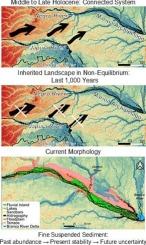马里乌群岛的地貌景观:巴西亚马逊盆地内格罗河的一个分支大型复杂系统
IF 3.1
2区 地球科学
Q2 GEOGRAPHY, PHYSICAL
引用次数: 0
摘要
内格罗河,亚马逊河的主要左岸支流,展示了一个具有重要生态和水文地貌重要性的复杂河流系统。它的中下游具有独特的地貌景观,特别是mariu本文章由计算机程序翻译,如有差异,请以英文原文为准。

The geomorphological landscape of the Mariuá Archipelago: An anabranching megacomplex system in the Negro River, Amazon Basin (Brazil)
The Negro River, the Amazon's principal left-bank tributary, exhibits a complex fluvial system of significant ecological and hydrogeomorphological importance. Its middle and lower reaches feature distinctive geomorphological landscapes, notably the Mariuá and Anavilhanas archipelagos, which serve as exemplary sites for investigating large anabranching rivers. This study examines the geomorphology of the Mariuá Archipelago through analysis of water dynamics, fluvial units, and sedimentary characteristics. We evaluated seasonal water level variations, erosion-transport-deposition processes, and grain-size distributions of islands and floodplains, complemented by comprehensive mapping of river units. Volumetric analysis reveals the fundamentally incomplete nature of the Mariuá floodplain, with the degree of incompleteness varying spatially from 30 % in upstream reaches to 60 % downstream, reflecting both temporal progression of filling and interruption of sediment input. The archipelago exemplifies an inherited fluvial landscape in permanent non-equilibrium, maintained by the Negro River's low suspended sediment concentration (3.2 × 106 ton.year−1) and limited stream power. Islands and floodplains comprise predominantly fine sediments (silt, clay, and very fine sand) stabilized by dense vegetation, while sandbars consist of medium to fine sand with occasional granule deposits. Although floodplains function as sediment traps through their levee-depression morphology, current sediment supply cannot explain the archipelago's formation. We propose that the Mariuá Archipelago originated from Japurá River sediments deposited when paleochannels connected these basins, with sediment supply ceasing abruptly around 1000 BP. While this inherited landscape has remained morphologically stable for centuries, recent analysis (2014–2024) reveals a 33 % increase in erosion and 83 % increase in deposition, suggesting the system may be approaching a stability threshold. Climate change and intensifying extreme hydrological events pose significant risks to this delicate equilibrium, potentially triggering irreversible morphological transformations in this unique Amazonian landscape.
求助全文
通过发布文献求助,成功后即可免费获取论文全文。
去求助
来源期刊

Geomorphology
地学-地球科学综合
CiteScore
8.00
自引率
10.30%
发文量
309
审稿时长
3.4 months
期刊介绍:
Our journal''s scope includes geomorphic themes of: tectonics and regional structure; glacial processes and landforms; fluvial sequences, Quaternary environmental change and dating; fluvial processes and landforms; mass movement, slopes and periglacial processes; hillslopes and soil erosion; weathering, karst and soils; aeolian processes and landforms, coastal dunes and arid environments; coastal and marine processes, estuaries and lakes; modelling, theoretical and quantitative geomorphology; DEM, GIS and remote sensing methods and applications; hazards, applied and planetary geomorphology; and volcanics.
 求助内容:
求助内容: 应助结果提醒方式:
应助结果提醒方式:


